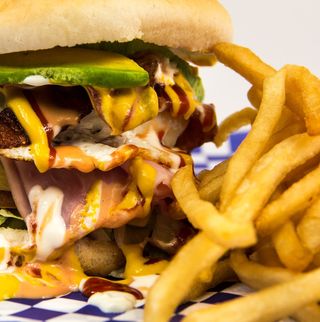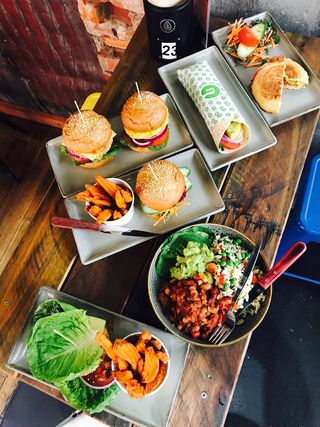Appetite
How to Eat Less Food When Eating Out
Being offered a doggy bag helps reduce consumption.
Posted October 7, 2018

How to eat less? That is the question on many people's mind—whether they are obese, overweight, or at the upper end of the healthy weight range. When eating at restaurants, in particular, many find that they eat more than planned. New research, to be published in the upcoming October issue of Appetite, suggests that being given the option to take uneaten food home may help reduce food intake.
Research on portion size and eating habits
Research has found that when people are served larger portions, they eat more; worse yet, they often do not adjust for this added energy intake at their next meal. They eat just as much.
In one laboratory study, participants were served four different sized portions of macaroni and cheese (on different days). When given the largest portion (1000g), they consumed 30% more than when given the smallest portion (500g). Surprisingly, participants in all conditions reported feeling similar levels of hunger and satiety.2
In another investigation, participants were served afternoon snacks of potato chips (which came in five different prepackaged sizes). When female and male participants were served the 170 g (compared to the 85 g) package of chips, they ate 18% and 37% more chips, respectively. They did not compensate for this additional food intake by eating less when dinner was served a few hours later.2
How do these findings extend to real-life settings, like eating in a restaurant? Could having the option to take away the uneaten portion of one’s meal (i.e. in a doggy bag) counteract the effect of portion size? Or would people eat just as much as before?
That is what Zuraikat and colleagues attempted to find out.
Portion size and doggy bag option
The present investigation utilized a crossover design and ran for four weeks. Participants were 58 women (aged 18-60); because a few participants withdrew from the study, the final analysis included 53 women only. No men were included in order to reduce variability in food consumption (also to increase statistical power).1
Participants were randomly assigned to a control (26) or a To-Go group (27). The two groups were similar in all measured characteristics, such as body mass index (BMI; a measure of an individual’s weight/height relationship), price consciousness, aversion to wasting food, etc.
Participants’ average age was 29. About 80% were White. Nearly 36% were overweight/obese (mean body mass index was 25).
Each week, participants would come to the lab to eat dinner. On the day of the experiment, they were asked to refrain from drinking alcohol the whole day, and from eating snacks three hours prior to their scheduled appointment.
Four food portion sizes were used; these varied between meals on different days, increasing all the way to almost double (175%) the baseline size. The meals included chicken breast with creamy Parmesan sauce, pasta with garlic and butter, broccoli with butter, garlic bread, grapes, and water.
Baseline portion size was 560 grams (828 kilocalories). The largest portion size, which was 175% of the original, was 980 grams (1449 kilocalories).
The “To-Go” group was informed, prior to their meal, that they had the option to take away the uneaten portion of their meal in a doggy bag. The control group was not informed of this option.
Could being merely informed about the option to use a doggy bag really make any difference in how much an individual consumes? Let us look at the results.

As expected, women in the control group ate more when portion sizes were increased. Specifically, for every 100 grams added to the original portion, they ate an average of 64 additional grams of food. As portion sizes were further increased, participants did not consume as much additional food, and the consumption eventually leveled off.
In the To-Go group, on the other hand, for every added 100 grams of food, participants consumed an average of 17 additional grams of food (compared to 64 grams in the control group).
More importantly, despite different levels of intake, ratings of hunger, fullness, and satisfaction, were similar in both groups.
The amount of food that participants ate was also influenced by two other factors: slowness of eating and price consciousness.
In the control group, as portion sizes increased, those who ate more slowly consumed less additional food.
Price consciousness had the opposite effect. In both groups, when given larger portion sizes, people who were more price conscious ate more.
Implications: Take a doggy bag and eat slowly
In order to gain less weight or to lose weight, it might be useful to consider the doggy bag option, when eating out; specifically, ask for a doggy bag when eating in restaurants, or take a doggy bag with you to fast food places that do not offer a to-go option. Do so especially if you are price-conscious, and are more likely to order a large meal if it is a great value. Also, do not forget to eat slowly.
References
1. Zuraikat, F. M, Roe, L. S., Smethers, A. D., & Rolls, B. J. (2018). Doggy bags and downsizing: Packaging uneaten food to go after a meal attenuates the portion size effect in women. Appetite, 129, 162-170.
2. Rolls, B. J. 2003. The supersizing of America: Portion size and the obesity epidemic. Nutrition Today, 38, 42–53.




